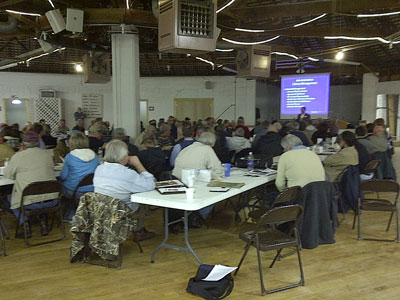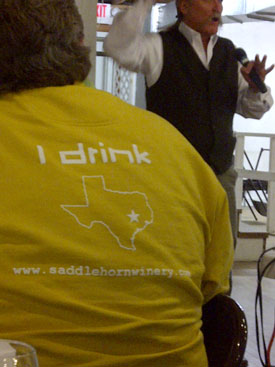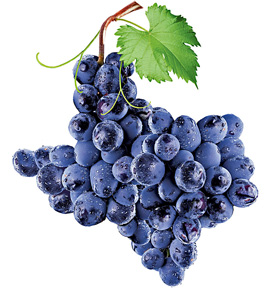And What a Year It Was! Tales from 20th Gulf Coast Grape Growers Day
Gulf Coast grape growers and an increasing assemblage of the grape-growing-curious assembled at the historical Cat Spring Ag Society Hall last week to hear a series of lectures that included extension viticulturalists, area grower-winemakers and people that write grape contracts and employee manuals. The point pondered at the start of the meeting was: What was the 2011 vintage like? Well, it doesn’t take a local vigneron to know that last summer was dry, dry, dry and hot, hot hot! But, Texas AgriLife extension viticulturalist, Fritz Westover, started the show by summing up what happened to our two local (and favorite) Gulf Coast wine grapes: Blanc Du Bois (the white) and Lenoir, aka Black Spanish (the red).
Fritz Westover, Texas Agrilife Extension Program Specialist, acknowledged that the winds were stronger and temperatures higher than normal during the summer of 2011. The rain (you might say, “What rain?”) was down 18 to 38 inches across the Gulf Coast. When you figure that our area normally gets about 50 inches of rain during a typical year a loss of 18 to 38 inches left us with a rainfall deficit of between 36 to 76 percent, depending on your specific location. That’s dry enough to make your spit dry up before it hits the ground. However, that said, the Gulf Coast generally fared better than the central, northern or western parts of the state. As long as a grape grower’s well was flowing, they generally fared better than those that farmed row crops that are generally not irrigated.
By the numbers, Blanc Du Bois and Lenoir grapes did well as long as they weren’t over cropped or left to die of thirst. Well managed vineyards produced Blanc Du Bois with slightly higher acid (pH 3.6 and titratable acid 5-6) and sugars at harvest (Brix 20-22) than usual. The heat brought the Blanc Du Bois harvest 7-10 days earlier than normal. Fritz’s assessment was that the 2011 Blanc Du Bois harvest will make decent dry, off-dry and sweet wines with aromatic stone fruit (peach and apricot) and tropical fruit characteristics, perhaps more so than the typical citrus qualities particularly common in the dry wines in 2010. Grape harvest yields in 2011 were down by 20-30% from 2010 (which was a particularly large harvest year). This reduction in yield was primarily due to smaller berry size resulting in more concentrated juice and flavorful wines.
For Black Spanish, sugar levels at harvest were generally between 23-26 Brix with acids coming in at pH 3.5-3.7 and titratable acidity of 6.5 to 9.0. Fritz suggested that the preferred wine style will be off-dry table wines or sweet, blush or port-style wines. When comparing the past four harvest years (2008 thru 2011), the cluster size was down from that in 2009 and 2010, due to the drought and desiccation of the grapes. But, the clusters size was still higher than recorded in 2008.
Challenges going forward into the 2012 grape growing season on the Gulf Coast are managing the stress caused by the drought on the vines. This will require watering (but Mother Nature as already helped in this area with recent and plentiful rains), application of fertilizers and administration of viticultural practices such as judicious winter and spring pruning.
With Fritz’s comments to set the stage, we had a tasting of a dry table wine made from Washington County Black Spanish grapes by Saddlehorn Winery in Burton, Texas. If you haven’t been there, they’re just a short drive up the road from Houston on Route 290. The Black Spanish red table wine made by Saddlehorn Winery was very palatable with pleasing red-black color in the glass, medium body and expressive red berry and plum nose and flavor with a floral aromatic note. This latter point came as a surprise to me as Black Spanish is typically known for its tar-like aromas rather than that of flowers. But, when combined with residual sugar and left to ferment its way up to 18% alcohol or get there with a dosage of brandy, it makes a mighty good port-style wine.
The accompanying discussion with the wine included something that I’d heard before about making a dry table from the Black Spanish grape. Many now say, “It’s a red grape that needs to be treated in the winery and fermented like a white grape.” By this, it is meant that the skins likely need to be separated from the juice prior to alcoholic fermentation to prevent unwanted bitterness and objectionable qualities in the wine. By comparison, most red vinifera grapes are macerated to produce a “must” comprised of grape juice, pulp and skins. This agglomeration typically gets an inoculation of yeast and is left to ferment. Therefore, making a dry table wine from Black Spanish grapes still seems to be a work-in-progress, but with progress being made.
There was a substantive discussion on the various techniques that can be used to extract the deep dark red/black color typical of Black Spanish wine without getting the tar-like characteristics. This may require a cold soak and removal of the grape skins prior to fermentation. But, there was little agreement on a preferred temperature of the soak or the length of time of the soak to get just the right characteristics. These are all real-time lessons in Gulf Coast winemaking. Stay tuned for more as I’m sure that I will be asked to taste quite a bit of Black Spanish wine in the months to come and I will try to keep you informed. From what I tasted here, I think that we are getting very close to the “formula”.
FINAL NOTE: Fritz mentioned that there were now at over 200 acres of wine grapes being grown on the Texas Gulf Coast. He also guessed that with the level of planting that he expected to take place this year, we could likely see 300 acres in a short period of time.





How soon before we get a Gulf Coast AVA, Russ?
Time will tell…..still a lot to work out. The process is underway and I will keep you posted.